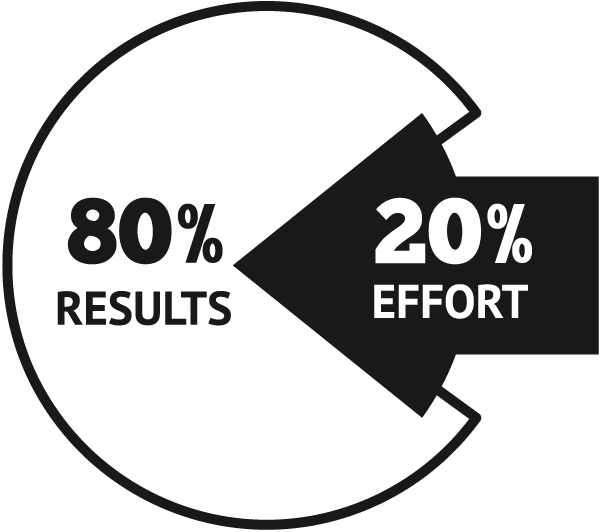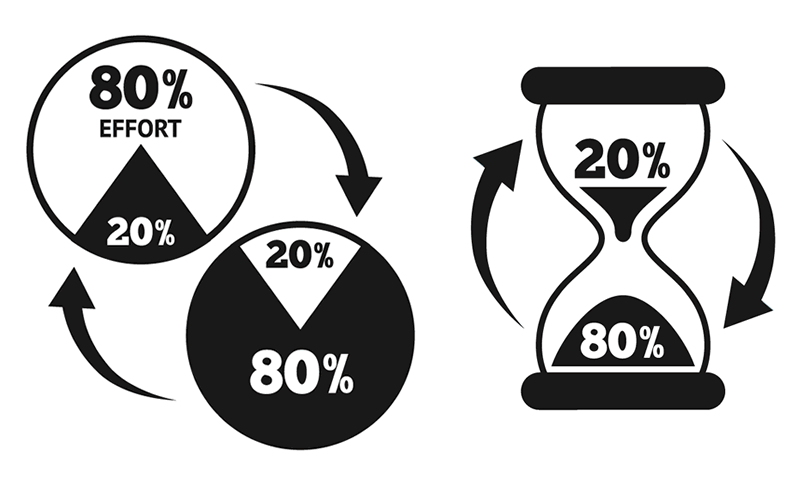The Pareto Principle (or Pareto Law) is perhaps one of the simplest concepts yet one of the most powerful. The principle can be applied to all aspects of life, from time-management to business, to marketing. In fact, you’ve probably come across it many times before without even realizing it. How? Because the Pareto Principle is also known as the 80/20 rule. It says that in most situations roughly 80% of its effects come from only 20% of its causes. It’s the law of the vital few and the principle of factor sparsity or put more simply, it’s the observation that most things in life are not distributed evenly. So where did this all come about?
The Pareto Principle and its History
In 1906, an Italian economist named Vilfredo Pareto founded this profound yet simple observation. The term was derived from his last name and refers to an observation the economist made regarding the wealth of Italy. He observed that 80% of Italy’s wealth belonged to only 20% of Italy’s population. He then took this one step further in his famous peapod experiment. Like with Italy’s wealth, he noticed that 80% of peas came from only 20% of the peapods. That simple observation had led to the less than obvious reality that most of the things in life are not really distributed equally.
Pareto then went beyond his current observations to testing his theory in other countries and in all sorts of distribution experiments. As expected, he found that the 80/20 principle applied to many circumstances. From his quantifiable results, Pareto concluded that the 80/20 rule is a standard measurement and management of all kinds of situations and their effects.
How the Pareto Principle Works
So why is the Pareto Principle so significant? Well, it plays a huge role in life, especially when it comes to business.
According to the principle or observation, in order to reach maximum and meaningful productivity in your business, you need to figure out what actions that take 20% of your time, produce 80% of your business results? Once you’ve uncovered that, you need to focus more time on those kinds of activities and less time on the others. As for making sales where the Pareto Principle may also be applied, it suggests that identifying the perspective and character of those customers who belong to that 20% that make up the 80% of your sales, will enable you to find more people like them.
One of the most common misconceptions about the 80/20 rule is that this ratio is absolute. This case is definitely not true. The numbers don’t have to be exactly 20% and 80% for this principle to apply. What it tries to point out is the fact that there is an unequal distribution of effort in every business as well as in other aspects. It is a reflection of the reality that some do more than others and these are those who contribute greatly to the progress of the task.
Here are a few examples of situations where the Pareto Principle applies:
- 80% of results are from 20% of efforts
- 80% of sales are from the 20% sales people’s efforts
- 80% of problems that arise are from 20% of the causes
- 80% of profits come from 20% of the products a company sells
The 80/20 rule or Pareto Principle is very relevant. It gives you a couple of very effective tips for situations that you might face in your workplace, business or company. It suggests that you..
- Focus on rewarding the 20% of workers that contribute to the 80% of the results
- Focus on fixing 20% of the bugs that causes 80% of the crashes
- Focus on satisfying the 20% of your customers that contribute to the 80% of your revenue
Basically, the principle suggests that the focus should be placed on the most productive few who greatly contribute to the most satisfactory results. Focusing your effort on the 20% of those people or tasks will make the greatest difference instead on the 80% that doesn’t really do so much.
The 80/20 Rules in the Online World
The Pareto Principle does not only apply for groups of people but also for individuals who aim to be successful in their outputs. Here are some ways in which those who aspire the best for their online business and marketing should take note:
For Blogging: With blogging there’s usually a key 20% of elements within an individual blog article (think article headline) that have the most dramatic effect on results.
For Sales: 80% of a company’s sale is generated from the 20% of their efforts. Figure out the top 20% of marketing strategies that drive 80% of the results and focus on improving your sales through them. You can also look at this as 20% of your customers provide you with 80% of your profits. If you can pinpoint the exact audience that converts so well into paying customers, you can potentially increase your profits dramatically.
For Social Content: Don’t overwhelm your fan-base or social media following with endless promotions. Not only are they less likely to trust you or listen to you – they will think you’re scammy. Unfortunately, so many companies don’t understand this and we see them bombarding their social channels with boring promotions that no one cares about. 80% of the content on your social channels should be fun or informative. You want to provide them with valuable and engaging content and only 20% of your posts should be promotional.
For Affiliate Marketing: 80% of your sales come from the 20% of your affiliates. Find the products or services that generate the most income (the 20%) and drop the rest (80%) that only provide marginal results.

Inputs vs Outputs: Making the Effort
Most humans are good consumers – we are good at taking inputs. However, how many of you after reading this article will actually go about making the necessary changes? Very few.
To foster the 80/20 lifestyle you need to seriously sit yourself down and assess your current lifestyle. Think of your goals, whether business, financial, health, relationships, happiness etc. What are the top 20% of actions that are giving you 80% of the results? Or if you haven’t actually started towards any of your goals yet, what are the top 20% of actions steps you need to take, that will give you 80% of the results.
One of the biggest reasons so many people fail in achieving their goals is fear. Don’t let fear stop you. Fear of failure (how ironic), lack of security, reduce paycheck, uncertainty – all of it stems from self-doubt and a lack of self-belief. People would much rather remain in their comfort zones and not bother to make the effort to drastically improve their current lifestyle. We are a consumer society (inputs) through goods, tv, phone, social media, instant gratification and so on.
One of the greatest things about the Pareto Principle or the 80/20 rule, is that it actually tries to make things easier for you! You could even say it’s the lazy man’s guide to achieving what you want. Because it’s not about extreme changes and strict routines – it’s about recognizing what 20% of things you do already on a daily basis, accounts for 80% of the results you want! Unfortunately, people would much rather be a consumer (inputs) and not bother to make the effort (outputs) of applying such a basic principle into their daily lives in whatever area they want to improve upon. Make the effort, be an output. Find what you are good at and maximize it. Recognize the actions that produce the most results for you and your business and put your energy where the big rewards are.




